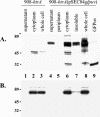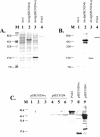Adaptation of the endogenous Salmonella enterica serovar Typhi clyA-encoded hemolysin for antigen export enhances the immunogenicity of anthrax protective antigen domain 4 expressed by the attenuated live-vector vaccine strain CVD 908-htrA
- PMID: 15557633
- PMCID: PMC529119
- DOI: 10.1128/IAI.72.12.7096-7106.2004
Adaptation of the endogenous Salmonella enterica serovar Typhi clyA-encoded hemolysin for antigen export enhances the immunogenicity of anthrax protective antigen domain 4 expressed by the attenuated live-vector vaccine strain CVD 908-htrA
Abstract
Bacterial live-vector vaccines aim to deliver foreign antigens to the immune system and induce protective immune responses, and surface-expressed or secreted antigens are generally more immunogenic than cytoplasmic constructs. We hypothesize that an optimum expression system will use an endogenous export system to avoid the need for large amounts of heterologous DNA encoding additional proteins. Here we describe the cryptic chromosomally encoded 34-kDa cytolysin A hemolysin of Salmonella enterica serovar Typhi (ClyA) as a novel export system for the expression of heterologous antigens in the supernatant of attenuated Salmonella serovar Typhi live-vector vaccine strains. We constructed a genetic fusion of ClyA to the reporter green fluorescent protein and showed that in Salmonella serovar Typhi CVD 908-htrA, the fusion protein retains biological activity in both domains and is exported into the supernatant of an exponentially growing live vector in the absence of detectable bacterial lysis. The utility of ClyA for enhancing the immunogenicity of an otherwise problematic antigen was demonstrated by engineering ClyA fused to the domain 4 (D4) moiety of Bacillus anthracis protective antigen (PA). A total of 11 of 15 mice immunized intranasally with Salmonella serovar Typhi exporting the protein fusion manifested fourfold or greater rises in serum anti-PA immunoglobulin G, compared with only 1 of 16 mice immunized with the live vector expressing cytoplasmic D4 (P = 0.0002). In addition, the induction of PA-specific gamma interferon and interleukin 5 responses was observed in splenocytes. This technology offers exceptional versatility for enhancing the immunogenicity of bacterial live-vector vaccines.
Figures



Similar articles
-
Salmonella enterica serovar Typhi live vector vaccines finally come of age.Immunol Cell Biol. 2009 Jul;87(5):400-12. doi: 10.1038/icb.2009.31. Epub 2009 May 5. Immunol Cell Biol. 2009. PMID: 19417771 Free PMC article. Review.
-
Enhanced immunity to Plasmodium falciparum circumsporozoite protein (PfCSP) by using Salmonella enterica serovar Typhi expressing PfCSP and a PfCSP-encoding DNA vaccine in a heterologous prime-boost strategy.Infect Immun. 2007 Aug;75(8):3769-79. doi: 10.1128/IAI.00356-07. Epub 2007 May 14. Infect Immun. 2007. PMID: 17502396 Free PMC article.
-
A new generation of stable, nonantibiotic, low-copy-number plasmids improves immune responses to foreign antigens in Salmonella enterica serovar Typhi live vectors.Infect Immun. 2010 Jan;78(1):337-47. doi: 10.1128/IAI.00916-09. Epub 2009 Nov 2. Infect Immun. 2010. PMID: 19884333 Free PMC article.
-
Oral administration of a Salmonella enterica-based vaccine expressing Bacillus anthracis protective antigen confers protection against aerosolized B. anthracis.Infect Immun. 2007 Apr;75(4):1827-34. doi: 10.1128/IAI.01242-06. Epub 2006 Dec 4. Infect Immun. 2007. PMID: 17145938 Free PMC article.
-
Animal models paving the way for clinical trials of attenuated Salmonella enterica serovar Typhi live oral vaccines and live vectors.Vaccine. 2003 Jan 17;21(5-6):401-18. doi: 10.1016/s0264-410x(02)00472-3. Vaccine. 2003. PMID: 12531639 Review.
Cited by
-
Anthrax protective antigen delivered by Salmonella enterica serovar Typhi Ty21a protects mice from a lethal anthrax spore challenge.Infect Immun. 2009 Apr;77(4):1475-82. doi: 10.1128/IAI.00828-08. Epub 2009 Jan 29. Infect Immun. 2009. PMID: 19179420 Free PMC article.
-
Salmonella as a vaccine delivery vehicle.Expert Rev Vaccines. 2013 Sep;12(9):1033-45. doi: 10.1586/14760584.2013.825454. Expert Rev Vaccines. 2013. PMID: 24053397 Free PMC article. Review.
-
Identification and immunological characterization of three potential vaccinogens against Cryptosporidium species.Clin Vaccine Immunol. 2011 Nov;18(11):1796-802. doi: 10.1128/CVI.05197-11. Epub 2011 Sep 14. Clin Vaccine Immunol. 2011. PMID: 21918117 Free PMC article.
-
Engineered Bacteria Enhance Immunotherapy and Targeted Therapy through Stromal Remodeling of Tumors.Adv Healthc Mater. 2022 Jan;11(2):e2101487. doi: 10.1002/adhm.202101487. Epub 2021 Nov 16. Adv Healthc Mater. 2022. PMID: 34738725 Free PMC article.
-
Salmonella enterica serovar Typhi live vector vaccines finally come of age.Immunol Cell Biol. 2009 Jul;87(5):400-12. doi: 10.1038/icb.2009.31. Epub 2009 May 5. Immunol Cell Biol. 2009. PMID: 19417771 Free PMC article. Review.
References
-
- Atkins, A., N. R. Wyborn, A. J. Wallace, T. J. Stillman, L. K. Black, A. B. Fielding, M. Hisakado, P. J. Artymiuk, and J. Green. 2000. Structure-function relationships of a novel bacterial toxin, hemolysin E. The role of αG. J. Biol. Chem. 275:41150-41155. - PubMed
-
- Balbas, P., X. Soberon, E. Merino, M. Zurita, H. Lomeli, F. Valle, N. Flores, and F. Bolivar. 1986. Plasmid vector pBR322 and its special-purpose derivatives—a review. Gene 50:3-40. - PubMed
-
- Blomfield, I. C., V. Vaughn, R. F. Rest, and B. I. Eisenstein. 1991. Allelic exchange in Escherichia coli using the Bacillus subtilis sacB gene and a temperature-sensitive pSC101 replicon. Mol. Microbiol. 5:1447-1457. - PubMed
-
- Collier, R. J., and J. A. Young. 2003. Anthrax toxin. Annu. Rev. Cell Dev. Biol. 19:45-70. - PubMed
Publication types
MeSH terms
Substances
Grants and funding
LinkOut - more resources
Full Text Sources
Other Literature Sources
Medical

